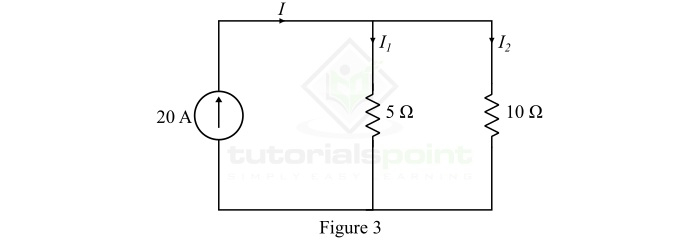
 Data Structure
Data Structure Networking
Networking RDBMS
RDBMS Operating System
Operating System Java
Java MS Excel
MS Excel iOS
iOS HTML
HTML CSS
CSS Android
Android Python
Python C Programming
C Programming C++
C++ C#
C# MongoDB
MongoDB MySQL
MySQL Javascript
Javascript PHP
PHP
- Selected Reading
- UPSC IAS Exams Notes
- Developer's Best Practices
- Questions and Answers
- Effective Resume Writing
- HR Interview Questions
- Computer Glossary
- Who is Who
Current Divider Rule and Voltage Divider Rule
Electric circuits are classified into two main types namely series circuit and parallel circuit based on the arrangement of components in the circuit. A series circuit is one in which the components are chain connected, while a parallel circuit is one in which all the circuit components are connected between two common points. Series circuits and parallel circuits act as voltage divider circuits and current divider circuits, respectively. Read through this article to find out more about Current Division Rule and Voltage Division Rule.
Current Division Rule
A parallel circuit acts as a current divider as it divides the total circuit current in its all branches. Figure1 shows a current divider circuit in which the total circuit current I has been divided into currents I1 and I2 in two parallel branches with resistances R1 and R2. Although, we can notice that the voltage drop across both resistances is same, i.e., V.

According to Ohm's law,
$$\mathrm{I_{1}=\frac{V}{R_{1}}\: and\:I_{2}=\frac{V}{R_{2}} }$$
Let R is the equivalent resistance of the circuit, and it is given by,
$$\mathrm{R=\frac{R_{1}R_{2}}{R_{1}+R_{2}}\: \: \cdot\cdot\cdot\left ( 1 \right )}$$
Also, from the circuit, we get,
$$\mathrm{I=\frac{V}{R}=V\times \left ( \frac{R_{1}+R_{2}}{R_{1}R_{2}} \right )\: \:\cdot \cdot \cdot \left ( 2 \right )}$$
But, we know that the voltage across both resistances is same.
$$\mathrm{\therefore V=I_{1}R_{1}=I_{2}R_{2}\: \: \cdot \cdot \cdot \left ( 3 \right )}$$
Hence, from equations (2) & (3), we finally get,
$$\mathrm{ I=I_{1}R_{1}\left ( \frac{R_{1}+R_{2}}{R_{1}R_{2}} \right )=I_{1}\left ( \frac{R_{1}+R_{2}}{R_{2}} \right )}$$
$$\mathrm{\therefore I_{1}=\frac{IR_{2}}{R_{1}+R_{2}}\: \: \cdot \cdot \cdot \left ( 4 \right )}$$
Similarly,
$$\mathrm{ I=I_{2}R_{2}\left ( \frac{R_{1}+R_{2}}{R_{1}R_{2}} \right )=I_{2}\left ( \frac{R_{1}+R_{2}}{R_{1}} \right )}$$
$$\mathrm{\therefore I_{2}=\frac{IR_{1}}{R_{1}+R_{2}}\cdot \cdot \cdot \left ( 5 \right )}$$
Equations (4) and (5) give the expressions of current division rule. From these equations, we may state that the current in any of the parallel branches is equal to the ratio of opposite branch resistance to the sum of all resistances, multiplied by the total circuit current.
Voltage Division Rule
A series circuit acts as a voltage divider as it divides the total supply voltage into different voltages across the circuit elements. Figure2 shows a voltage divider circuit in which the total supply voltage V has been divided into voltages V1 and V2 across two resistances R1 and R2. Although, the current through both resistances is same, i.e., I.

According to Ohm's law,
$$\mathrm{V_{1}=IR_{1}\: and\: V_{2}=IR_{2}}$$
Let R is the total resistance of the circuit, and it is given by,
$$\mathrm{R=R_{1}+R_{2}\: \: \: \cdot\cdot \cdot \left ( 1 \right ) }$$
Also, from the circuit, we have,
$$\mathrm{V=IR=I\left ( R_{1}+R_{2} \right )\: \: \: \cdot\cdot \cdot \left ( 2 \right ) }$$
But
$$\mathrm{I=\frac{V_{1}}{R_{1}}=\frac{V_{2}}{R_{2}}\: \: \cdot \cdot \cdot \left ( 3 \right ) }$$
Therefore, from equations (2) & (3), we finally get,
$$\mathrm{V=\frac{V_{1}}{R_{1}}\left (R_{1}+R_{2}\right ) }$$
$$\mathrm{\therefore V_{1}=\frac{VR_{1}}{R_{1}+R_{2}}\: \: \cdot \cdot \cdot \left ( 4 \right )}$$
Similarly,
$$\mathrm{V=\frac{V_{2}}{R_{2}}\left (R_{1}+R_{2}\right ) }$$
$$\mathrm{\therefore V_{2}=\frac{VR_{2}}{R_{1}+R_{2}}\: \: \cdot \cdot \cdot \left ( 5 \right )}$$
Hence, from equations of voltage division rule, it may be said that the voltage across a resistor in a series circuit is equal to the product of the value of that resistor and the total supply voltage, divided by the total resistance of the series resistors.
Numerical Example (1)
Find the currents I1 and I2 in the parallel circuit shown in Figure3

Solution
Using the current division rule, the current through resistor R1 is,
$$\mathrm{I_{1}=I\times \frac{R_{2}}{R_{1}+R_{2}}=20\times \frac{10}{5+10}}$$
$$\mathrm{\therefore I_{1}=13.33\: A}$$
The current through resistor R2 will be,
$$\mathrm{I_{2}=I\times \frac{R_{1}}{R_{1}+R_{2}}=20\times \frac{5}{5+10}}$$
$$\mathrm{\therefore I_{2}=6.67\: A}$$
Numerical Example (2)
Find the voltage across resistors R1 and R2 in the circuit shown in Figure-4.

Solution
Using the voltage division rule, the voltage across resistor R1 will be,
$$\mathrm{V_{1}=\frac{VR_{1}}{R_{1}+R_{2}}=\frac{12\times 6}{6+10}= 4.5 V}$$
The voltage across the resistor R2 will be,
$$\mathrm{V_{2}=\frac{VR_{2}}{R_{1}+R_{2}}=\frac{12\times 10}{6+10}= 7.5 V}$$
Summary
The following points summarize what we discussed in this article ?
A parallel circuit acts as a current divider circuit because it divides the total circuit current in its all branches.
A series circuit acts as a voltage divider circuit because it divides the total supply voltage in different voltages across various component of the circuit.
The current division rule states that the current in any of the parallel branches of a parallel circuit is equal to the ratio of opposite branch resistance to the sum of all resistances, multiplied by the total current.
The voltage division rule states that the voltage across any of the series components in a series circuit is equal to the product of value of that resistance and the total supply voltage, divided by the total resistance of the series circuit.

